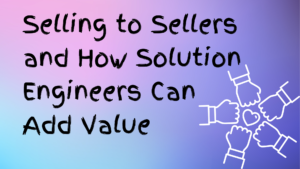
Blog
In the ever-changing world of sales, identifying a competitive edge is paramount. For most sales teams, however, keeping on top of the numerous competitors in their market and the array of solutions they offer is a challenge. So, as sales or presales leaders, how are you meant to arm your team with the information they need to highlight the value of your solution and point out potential gaps in competing offers?
The answer is to create detailed competitor battlecards. For those unfamiliar with the term, a competitor battlecard is a strategic document that details critical information about a competitor and its product offering. Think of it like a cheat sheet that allows a salesperson or presales consultant to get up to speed on a competitor and quickly understand their strengths, weaknesses, and positioning in the market.
Not all competitor battlecards are created equal, however. In many instances, companies and the sales organization supporting front-line account executives and presales consultants fail to make them as relevant as possible or as updated as needed.
In this article, we will break down the key components of a competitor battlecard, identify the advantages of using them in your sales cycle, and show how, when treated as a “living and breathing document,” they can help accelerate the sales cycle and improve win rates.
Key Components Of An Effective Battlecard
Creating an effective battlecard that can genuinely empower your enterprise sales team by providing comprehensive information about your competitors is crucial. By arming your sales reps with a well-crafted battlecard, they can navigate the competitive landscape more efficiently and tailor their approach during sales conversations. Let’s delve into the essential elements that make up an effective battlecard.

- Competitor Overview: Providing an overview of a competitor, their product offering, and the market they sell to provides sales and presales teams with the high-level insight they need to understand the key competitors they are likely to face. In this section of a battlecard, you should also highlight information such as their key customers and target industries.
- Product Offerings: Information on the products or solutions offered by the competitor. In particular, information in this section of the battlecard should focus on how your solution positions against these capabilities and highlight both product strengths and weaknesses.
- Why You Win and Why You Lose (AKA Strengths and Weaknesses): You have competition because the companies you go up against can also sell their product or service. Please don’t fall into the trap of thinking everything about them or their offering is terrible. Be realistic. Point out where they are strong. And where they are weak. By being honest, you arm your team with much more actionable intelligence.
- Market Positioning & Pricing: Sometimes, you can find a competitor who is going after a completely different market sector than you. They might focus on enterprise. You may put more effort into selling to SMBs. Either way, ensuring your team understands how a competitor will likely position themselves within the market can be very worthwhile. It helps qualify out of opportunities if they are after a lower-cost solution or highlight how your price competitiveness could be an advantage if you are going up against a vendor with a premium pricing strategy.
- Insight from existing opportunities: One of the main shortfalls in competitor battlecards is that they are created with historical data and don’t consider the intelligence being collected daily by your sales and presales team who are engaged in opportunities. Highlighting opportunities where you are currently involved with a competitor or have recently won or lost against them can improve the relevancy of the information you provide and enhance collaboration within your team.
Getting competitor battlecards right sounds straightforward on the surface. However, the recency and relevancy of the data is a key consideration. To help sales and presales teams overcome this problem, you can leverage solutions like Oqire, a tool for sales and presales teams that makes it easy to create competitor battlecards and ensure they remain up-to-date by automatically linking to recent opportunities where you have engaged won or lost against that competitor. This ensures that your sales and presales team has access to the most up-to-date and recent information. You are also collecting intel from the field. This information is unlikely to be published on competitor websites or product sheets and can help give your entire sales team an edge.
Key Components Of An Effective Battlecard
There are numerous advantages to using competitor battlecards throughout the sales cycle. They are valuable to both sales and presales teams and, when used correctly, can help improve the qualification process, improve sales proposals and product demos, and ultimately help reduce the length of the sales process.
Knowledge is Power
Empowered with the insights from battlecards, sales representatives are not just reacting to the market; they are proactively shaping conversations. When creating a battlecard whether it be using your own template or with tools like Oqire, surfacing information such as “why you win” or “why you lose” can prearm the sales team with the intel they need to handle objections and assure the prospect of the key reasons why customers chose your solution over the competition.

- Anticipating Objections: Before a potential client points out an advantage a competitor might have, a sales representative can preemptively address it. This proactive approach showcases that the representative is not only well-informed but is also confident in the superiority of their product or service.
- Data-Backed Rebuttals: When faced with objections, having data at one’s disposal allows for immediate and convincing rebuttals. It’s not about dismissing a client’s concerns but addressing them with concrete information, thereby positioning oneself as a reliable and informed consultant.
Boosts Confidence
A well-prepared salesperson is a confident salesperson. The benefits of this confidence are manifold:
- Commanding Presence: When a representative knows the ins and outs of their competitors, they exude a sense of authority. This can significantly influence a client’s perception and trust in the representative.
- Reduced Hesitation: With all the necessary information at their fingertips, representatives can answer questions promptly, reducing awkward pauses or uncertain answers during pitches.
- Building Credibility: Over time, consistently showcasing in-depth knowledge solidifies a representative’s reputation as a subject matter expert, making clients more receptive to pitches and discussions.
Streamlines Strategy
Rather than shooting in the dark, battlecards offer a strategic advantage:
- Targeted Approaches: Understanding competitors means understanding the gaps in their offerings. Sales teams can tailor their pitches to highlight their product’s strengths against these gaps, ensuring that the client sees the clear advantages of choosing their product or service.
- Efficient Preparation: Instead of spending hours researching or trying to recall competitor data, representatives have a ready reference. This saves time and ensures that the most recent and relevant information is always used in discussions.
- Consistency in Messaging: With all representatives equipped with the same battlecard, a consistent message is relayed to potential clients, regardless of which representative they’re speaking to. This uniformity in messaging reinforces the brand’s reliability.
Competitor Battlecards are not just a tool; they are a transformative force in the world of sales. By equipping sales teams with the knowledge, bolstering their confidence, and streamlining their sales strategy, battlecards ensure that every sales conversation is approached with precision, clarity, and authority.
How To Integrate Battlecards Into Every Phase Of The Sales Journey

Competitor Battlecards aren’t just a one-off resource to glance over; they’re a strategic tool meant to be integrated throughout the sales process. From the first interaction with a potential client to the moment the deal is sealed, battlecards can significantly enhance the efficacy and impact of the sales journey. Here’s how:
1. Initial Contact: Crafting a Tailored Pitch
The first impression is often the most lasting, and in the world of sales, it can make or break a potential deal. With battlecards in hand:
- Understanding the Competition: Before reaching out, sales representatives can quickly review the battlecard to understand the competitor products or services a prospect might be considering.
- Highlighting Unique Selling Points (USPs): Using this knowledge, the pitch can be tailored to emphasize how your offering excels where competitors fall short. This ensures that from the very first interaction, the potential client is made aware of the distinctive advantages of your product or service.
- Engaging with Relevance: Battlecards allow sales representatives to engage in a conversation that feels personal and relevant to the prospect, as they can immediately address the specific needs or concerns the prospect might have based on the competitor landscape.
2. Product Demonstrations: Proactively Addressing Queries
When showcasing your product or service, anticipation is key. Battlecards can assist by:
- Preempting Questions: By understanding common inquiries or concerns raised about competitors, sales representatives can weave those answers into their demonstrations, even before they’re asked.
- Data-Driven Showcases: Instead of just stating that your product is superior, representatives can use data and insights from the battlecard to show it. This could be in the form of benchmarks, case studies, or direct feature comparisons.
- Building Trust: Demonstrating this level of preparedness and knowledge highlights the product’s strengths and builds trust with the potential client. It assures them that the representative understands the industry and has done their homework.
3. Closing the Deal: Making a Compelling Case
As discussions reach their climax, and it’s time to seal the deal, battlecards become invaluable:
- Reinforcing the Value Proposition: Representatives can remind the potential client of key differentiators that set your product or service apart, using insights directly from the battlecard.
- Addressing Last-Minute Objections: If a prospect brings up a sudden objection inspired by a competitor’s offering, the battlecard can provide an immediate, data-backed response to address it.
- Building a Forward-Looking Vision: Beyond just the immediate deal, insights from the battlecard can help paint a picture of the ongoing value and future advantages of choosing your solution over competitors
.
In sum, Competitor Battlecards are not just reference sheets to be consulted now and then; they are dynamic tools that, when integrated correctly, can elevate the entire sales journey. From the first hello to the final handshake, they provide the insights and data required to engage effectively, respond intelligently, and close decisively.
Ensuring the Continued Efficacy of Battlecards in a Dynamic Business Environment
In the rapidly shifting terrains of the business world, stagnation can spell obsolescence. Competitor Battlecards, despite their initial thoroughness, can lose their effectiveness if they aren’t updated to mirror these changes. Maintaining their relevance is not just about periodic updates; it’s about adopting a proactive, feedback-driven approach to ensure they always offer a strategic advantage. Here’s a deeper dive into keeping battlecards pertinent:
1. Scheduled Revisions: The Quarterly Review

Setting aside dedicated time for periodic reviews ensures that battlecards never become outdated. This quarterly check can:
- Incorporate New Competitors: As new players emerge in the market, they should be added to your battlecards to ensure comprehensive coverage. Ideally, you should look to leverage a sales and presales tool that automatically links the competitors noted on opportunities with the battlecards you have available for them. This is one of the key capabilities in Oqire that helps to keep battlecards up to date and relevant for your team.
- Adjust for Market Shifts: Changes in market dynamics, such as regulatory shifts or broad industry trends, can be integrated, ensuring the battlecard remains contextually relevant.
- Refine Data Points: As more data becomes available – be it from market research, sales interactions, or other sources – the battlecard can be refined to be more accurate and insightful.
2. Ground-Level Feedback: Tapping into Sales Insights
Sales teams are on the frontline, interacting with clients, facing objections, and navigating competitors daily. Their feedback is invaluable:
- Real-time Relevance: By tapping into their experiences, battlecards can be updated with the most recent objections or queries they face.
- Identifying Gaps: Sales representatives can point out areas where they felt the battlecard was lacking or where additional information could have helped close a deal.
- Testimonials and Anecdotes: Real-world examples or stories from the field can be powerful tools when integrated into battlecards, making them more relatable and impactful.
3. Vigilant Monitoring: Staying Atop Competitor Movements
Competitors aren’t static; they pivot, innovate, and rebrand. By keeping a close eye on their movements, battlecards can be updated proactively:
- Product Launches: Whenever a competitor launches a new product or updates an existing one, battlecards should be revised to reflect these changes.
- Marketing Campaigns: Monitoring competitors’ marketing initiatives can provide insights into their strategic focus, target demographics, and value propositions.
- Public Relations and News: Keeping tabs on news articles, press releases, or public communications from competitors can offer a wealth of information. This could be about strategic partnerships, expansions, or even challenges they’re facing.
In conclusion, Competitor Battlecards, though initially comprehensive, requires a commitment to continuous refinement to maintain their strategic edge. With structured revisions, feedback-driven improvements, and vigilant competitor monitoring, battlecards can remain the indispensable tools they are meant to be, always ready to give sales teams the advantage they need in the ever-changing business arena.
Key Takeaways
In the intricate dance of sales, knowledge, and preparation often dictate the rhythm. Competitor Battlecards, when effectively crafted, maintained, and utilized, offer sales teams an unparalleled edge, turning every interaction into a choreographed performance. From the initial contact with a potential client to the decisive moments of closing a deal, these battlecards serve as a guiding light, illuminating the path to sales success.
However, their potency doesn’t solely lie in their existence but in their relevance. As the business world continues its relentless evolution, the commitment to regularly refine and update these cards ensures they remain not just pertinent but powerful. By integrating ground-level insights, monitoring competitor movements, and ensuring strategic utilization throughout the sales journey, battlecards transform from mere tools to strategic assets.
In conclusion, in the competitive arena of sales, where every advantage counts, Competitor Battlecards stand out as indispensable allies. They encapsulate the essence of informed selling, ensuring that sales representatives are not just communicating but connecting, not just pitching but persuading. Embracing battlecards is, in essence, embracing a culture of excellence, preparedness, and strategic foresight, setting the stage for sustained success in the dynamic world of enterprise sales.
If you are looking to arm your sales and presales team with competitive insights, then get started with Oqire for free. Beyond competitor battlecards Oqire is a platform that helps bring sales and presales teams together, optimizing the sales qualification, discovery, and demo planning phase to increase deal velocity and closed-won-win rates.



